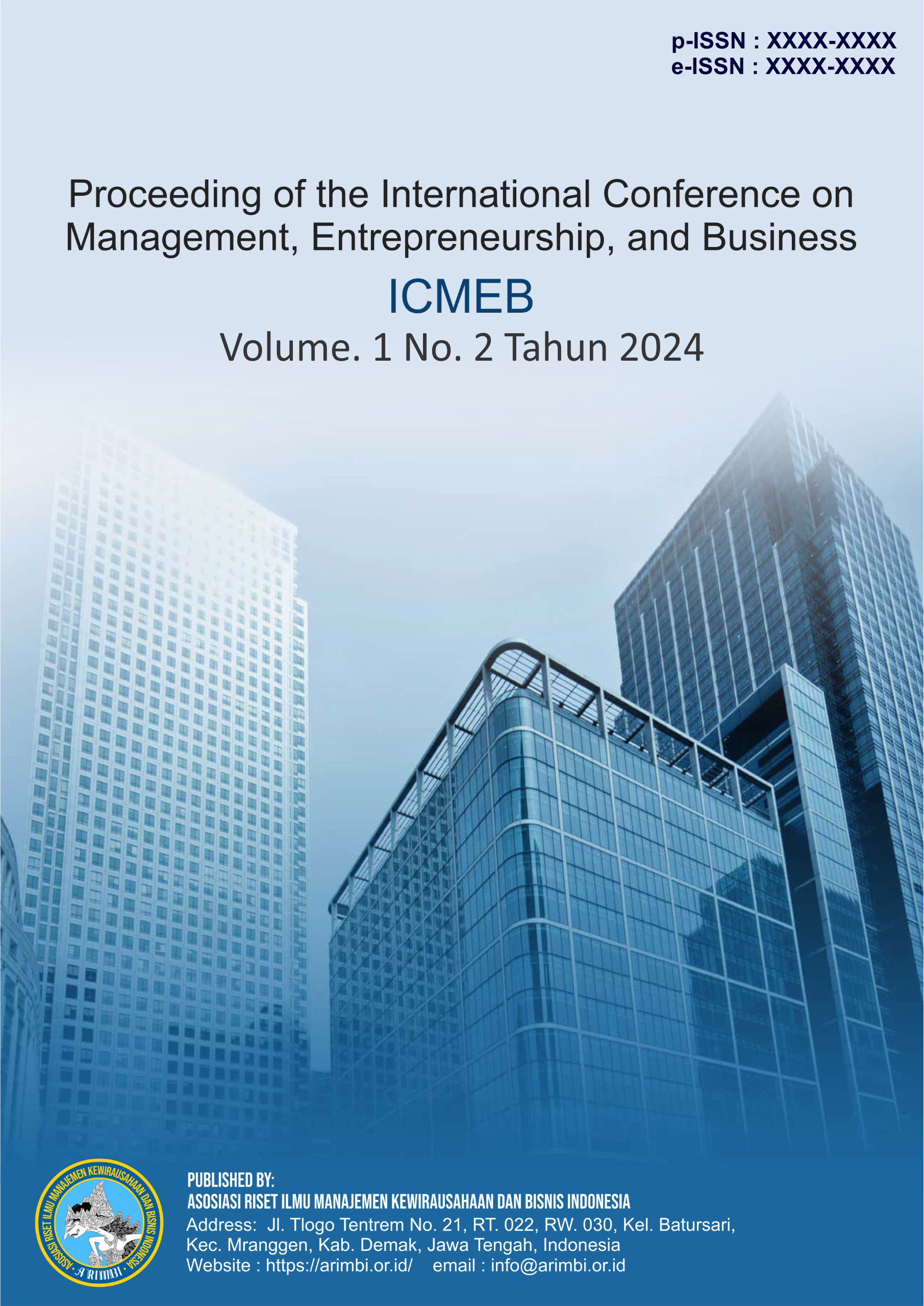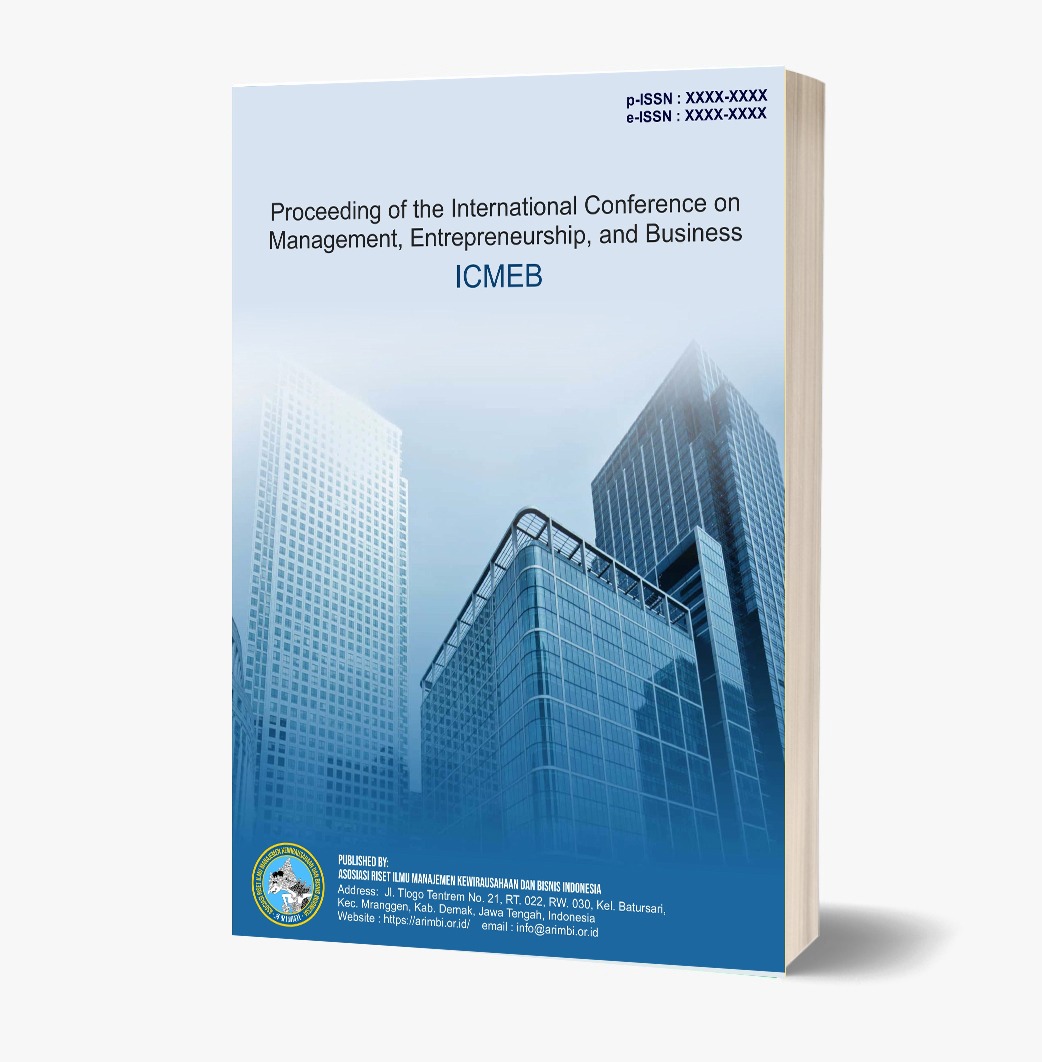The Role of Management Commitment and Leadership in Implementing Green HRM in Hotels
DOI:
https://doi.org/10.61132/icmeb.v1i2.126Keywords:
green HRM, management commitment, leadership, hospitality, AsiaAbstract
This study aims to investigate how top management commitment and leadership style influence the effectiveness of implementing green HRM practices in the hospitality industry. The study employs a qualitative approach by conducting case studies in selected hotels across Asian countries. Data is collected through in-depth interviews with hotel leaders and HR staff. Thematic analysis is performed to identify important patterns and insights related to the role of commitment and leadership in implementing green HRM initiatives. The results of this study are expected to provide a better understanding of the key factors that determine the successful adoption of green HRM practices in the Asian hospitality industry.
Downloads
References
Braun, V., & Clarke, V. (2006). Using thematic analysis in psychology. Qualitative Research in Psychology, 3(2), 77–101.
Chen, Y. S., Chuang, C. H., & Wu, W. C. (2018). The transformational leadership effect on green practices and performance: Evidence from hotel industry. Business Strategy and the Environment, 27(8), 1662–1674.
Creswell, J. W., & Miller, D. L. (2000). Determining validity in qualitative inquiry. Theory into Practice, 39(3), 124–130.
Dubey, R., Gunasekaran, A., Childe, S. J., Papadopoulos, T., Hazen, B., Giannakis, M., & Roubaud, D. (2017). Examining the effect of external pressures and organizational culture on shaping performance measurement systems (PMS) for sustainability benchmarking: Some empirical findings. International Journal of Production Economics, 193, 63–76.
Eisenhardt, K. M., & Graebner, M. E. (2007). Theory building from cases: Opportunities and challenges. Academy of Management Journal, 50(1), 25–32.
Faulkner, B., Moscardo, G., & Laws, E. (2000). Tourism in the twenty-first century: Reflections on experience. Continuum.
Guerci, M., Longoni, A., & Luzzini, D. (2016). Translating stakeholder pressures into environmental performance–the mediating role of green HRM practices. The International Journal of Human Resource Management, 27(2), 262–289.
Hofstede, G. (2001). Culture’s consequences: Comparing values, behaviors, institutions and organizations across nations. Sage Publications.
Hsiao, T. Y., Chuang, C. M., Kuo, N. W., & Yu, S. M. F. (2014). Establishing attributes of an environmental management system for green hotel evaluation. International Journal of Hospitality Management, 36, 197–208.
Hsu, C. C., Tan, K. C., Mohamad Zailani, S. H., & Jayaraman, V. (2019). Institutional pressures, green supply chain management practices and performance: Empirical evidence from Malaysian firms. International Journal of Operations & Production Management, 39(10), 1199–1222.
Kim, Y. J., Kim, W. G., Choi, H. M., & Phetvaroon, K. (2019). The effect of green human resource management on hotel employees’ eco-friendly behavior and environmental performance. International Journal of Hospitality Management, 76, 83–93.
King, N. (2004). Using templates in the thematic analysis of text. In C. Cassell & G. Symon (Eds.), Essential guide to qualitative methods in organizational research. Sage Publications.
Lincoln, Y. S., & Guba, E. G. (1985). Naturalistic inquiry. Sage Publications.
Luu, T. T. (2018). Employees’ green recovery performance: The roles of green HR practices and serving culture. Journal of Sustainable Tourism, 26(8), 1308–1324.
Luu, T. T. (2019). Building employees’ organizational citizenship behavior for the environment: The role of environmentally-specific servant leadership and a moderated mediation mechanism. International Journal of Contemporary Hospitality Management, 31(1), 406–426.
Mittal, S., & Dhar, R. L. (2016). Effect of green transformational leadership on green creativity: A study of tourist hotels. Tourism Management, 57, 118–127.
Moraes, S. S., Chiappetta Jabbour, C. J., Battistelle, R. A. G., Rodrigues, J. M., Renwick, D. S., Foropon, C., & Roubaud, D. (2018). When knowledge management matters: interplay between green human resources and eco-efficiency in the financial service industry. Journal of Knowledge Management, 23(9), 1691–1707.
Obeidat, S. M., Al Bakri, A. A., & Elbanna, S. (2018). Leveraging “green” human resource practices to enable environmental and organizational performance: Evidence from the Qatari oil and gas industry. Journal of Business Ethics, 1–18.
Patton, M. Q. (n.d.). Qualitative research and evaluation methods (3rd ed.). Sage Publications.
Pham, N. T., Tučková, Z., & Jabbour, C. J. C. (2019a). Greening the hospitality industry: How do green human resource management practices influence organizational citizenship behavior in hotels? A mixed-methods study. Tourism Management, 72, 386–399.
Pham, N. T., Tučková, Z., & Jabbour, C. J. C. (2019b). Greening the hospitality industry: How do green human resource management practices influence organizational citizenship behavior in hotels? A mixed-methods study. Tourism Management, 72, 386–399.
Pinzone, M., Guerci, M., Lettieri, E., & Huisingh, D. (2019). Effects of “green” training on pro-environmental behaviors and job satisfaction: Evidence from the Italian healthcare sector. Journal of Cleaner Production, 226, 221–232.
Pirani, S. I., & Arafat, H. A. (2014). Solid waste management in the hospitality industry: A review. Journal of Environmental Management, 146, 320–336.
Rawashdeh, A. (2018). The impact of green human resource management on organizational environmental performance in Jordanian health service organizations. Management Science Letters, 8(10), 1049–1058.
Ren, S., Tang, G., & Jackson, S. E. (2018a). Green human resource management research in emergence: A review and future directions. Asia Pacific Journal of Management, 35(3), 769–803.
Ren, S., Tang, G., & Jackson, S. E. (2018b). Green human resource management research in emergence: A review and future directions. Asia Pacific Journal of Management, 35(3), 769–803.
Renwick, D. W., Redman, T., & Maguire, S. (2013). Green human resource management: A review and research agenda. International Journal of Management Reviews, 15(1), 1–14.
Robertson, J. L., & Barling, J. (2013). Greening organizations through leaders’ influence on employees’ pro‐environmental behaviors. Journal of Organizational Behavior, 34(2), 176–194.
Rojšek, I. (2001). From red to green: Towards the environmental management in the country in transition. Journal of Business Ethics, 33(1), 37–50.
Roscoe, S., Subramanian, N., Jabbour, C. J., & Chong, T. (2019). Green human resource management and the enablers of green organisational culture: Enhancing a firm’s environmental performance for sustainable development. Business Strategy and the Environment, 28(5), 737–749.
Singh, S. K., Del Giudice, M., Chierici, R., & Graziano, D. (2020). Green innovation and environmental performance: The role of green transformational leadership and green human resource management. Technological Forecasting and Social Change, 150.
Siyambalapitiya, J., Zhang, X., & Liu, X. (2018). Green human resource management: A proposed model in the context of Sri Lanka’s tourism industry. Journal of Cleaner Production, 201, 542–555.
Stake, R. E. (1995). The art of case study research. Sage Publications.
Stalcup, L. D., Deale, C. S., & Todd, S. Y. (2014). Human resources practices for environmental sustainability in lodging operations. Journal of Human Resources in Hospitality & Tourism, 13(4), 389–404.
Tang, G., Chen, Y., Jiang, Y., Paille, P., & Jia, J. (2018). Green human resource management practices: Scale development and validity. Asia Pacific Journal of Human Resources, 56(1), 31–55.
Tuan, L. T. (2019). Effects of environmentally-specific servant leadership on green performance via green climate and green crafting. Asia Pacific Journal of Management, 1–31.
Tuan, N. P., Tuan, L. T., Yen, N. T. K., & Hai, N. T. T. (2017). Green human resource management and sustainable manufacturing in Vietnam: Investigating the influence of leadership and power distance. Management Science Letters, 7(12), 585–592.
Yin, R. K. (2018). Case study research and applications: Design and methods (6th ed.). Sage Publications.
Yusoff, Y. M., Nejati, M., Kee, D. M. H., & Amran, A. (2018). Linking green human resource management practices to environmental performance in hotel industry. Global Business Review, 21(3), 663–680.
Yusoff, Y. M., Nejati, M., Kee, D. M. H., & Amran, A. (2020). Linking green human resource management practices to environmental performance in hotel industry. Global Business Review, 21(3), 663–680.






